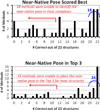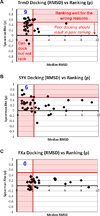CSAR 2014: A Benchmark Exercise Using Unpublished Data from Pharma
- PMID: 27149958
- PMCID: PMC5228621
- DOI: 10.1021/acs.jcim.5b00523
CSAR 2014: A Benchmark Exercise Using Unpublished Data from Pharma
Abstract
The 2014 CSAR Benchmark Exercise was the last community-wide exercise that was conducted by the group at the University of Michigan, Ann Arbor. For this event, GlaxoSmithKline (GSK) donated unpublished crystal structures and affinity data from in-house projects. Three targets were used: tRNA (m1G37) methyltransferase (TrmD), Spleen Tyrosine Kinase (SYK), and Factor Xa (FXa). A particularly strong feature of the GSK data is its large size, which lends greater statistical significance to comparisons between different methods. In Phase 1 of the CSAR 2014 Exercise, participants were given several protein-ligand complexes and asked to identify the one near-native pose from among 200 decoys provided by CSAR. Though decoys were requested by the community, we found that they complicated our analysis. We could not discern whether poor predictions were failures of the chosen method or an incompatibility between the participant's method and the setup protocol we used. This problem is inherent to decoys, and we strongly advise against their use. In Phase 2, participants had to dock and rank/score a set of small molecules given only the SMILES strings of the ligands and a protein structure with a different ligand bound. Overall, docking was a success for most participants, much better in Phase 2 than in Phase 1. However, scoring was a greater challenge. No particular approach to docking and scoring had an edge, and successful methods included empirical, knowledge-based, machine-learning, shape-fitting, and even those with solvation and entropy terms. Several groups were successful in ranking TrmD and/or SYK, but ranking FXa ligands was intractable for all participants. Methods that were able to dock well across all submitted systems include MDock,1 Glide-XP,2 PLANTS,3 Wilma,4 Gold,5 SMINA,6 Glide-XP2/PELE,7 FlexX,8 and MedusaDock.9 In fact, the submission based on Glide-XP2/PELE7 cross-docked all ligands to many crystal structures, and it was particularly impressive to see success across an ensemble of protein structures for multiple targets. For scoring/ranking, submissions that showed statistically significant achievement include MDock1 using ITScore1,10 with a flexible-ligand term,11 SMINA6 using Autodock-Vina,12,13 FlexX8 using HYDE,14 and Glide-XP2 using XP DockScore2 with and without ROCS15 shape similarity.16 Of course, these results are for only three protein targets, and many more systems need to be investigated to truly identify which approaches are more successful than others. Furthermore, our exercise is not a competition.
Figures





References
-
- Huang S-Y, Zou X. Ensemble Docking of Multiple Protein Structures: Considering Protein Structural Variations in Molecular Docking. Proteins Struct. Funct. Bioinforma. 2007;66:399–421. - PubMed
-
- Friesner RA, Murphy RB, Repasky MP, Frye LL, Greenwood JR, Halgren TA, Sanschagrin PC, Mainz DT. Extra Precision Glide: Docking and Scoring Incorporating a Model of Hydrophobic Enclosure for Protein-Ligand Complexes. J. Med. Chem. 2006;49:6177–6196. - PubMed
-
- Korb O, Stützle T, Exner TE. Empirical Scoring Functions for Advanced Protein−Ligand Docking with PLANTS. J. Chem. Inf. Model. 2009;49:84–96. - PubMed
-
- Sulea T, Hogues H, Purisima EO. Exhaustive Search and Solvated Interaction Energy (SIE) for Virtual Screening and Affinity Prediction. J. Comput. Aided Mol. Des. 2011;26:617–633. - PubMed
-
- Jones G, Willett P, Glen RC, Leach AR, Taylor R. Development and Validation of a Genetic Algorithm for Flexible Docking. J. Mol. Biol. 1997;267:727–748. - PubMed
Publication types
MeSH terms
Substances
Grants and funding
LinkOut - more resources
Full Text Sources
Other Literature Sources
Miscellaneous

